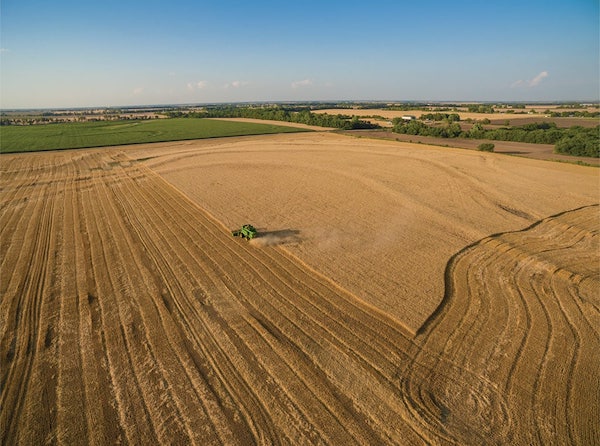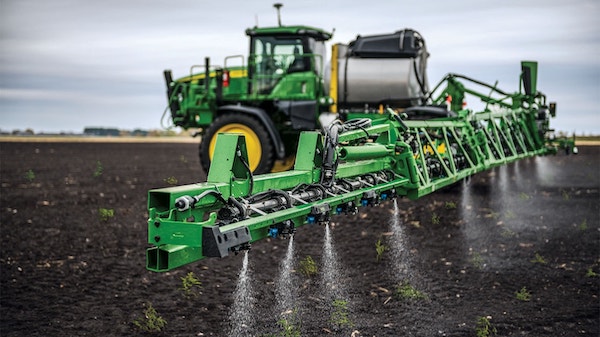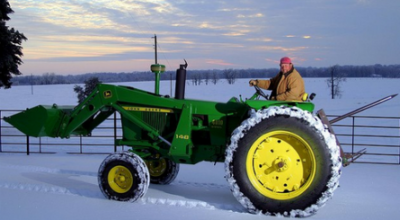As the seasons change, farmers across the country know they must change their focus, whether it be to planting, spraying, or harvesting. No matter the time of year, though, each producer must take various factors into consideration to get the most out of their land.

From crop diseases to equipment maintenance, these individuals cannot let anything fall under the radar if they are to succeed in their farming endeavors. This post will outline tips for farmers as they look to get the most out of their land, including:
- Metrics for Determining the Health of Crops
- Addressing Issues Impacting Crop Health
- Storage Tips for Farmers
Metrics for Determining the Health of Crops
As in any line of business, farmers monitor certain metrics to determine how successful they can truly be, whether they are planning for the planting season or are in the middle of their harvest season. This includes the following.
Crop Appearance
When determining the health of their crops, one of the first things that farmers consider is appearance. While this is not a foolproof method, something like leaf color, for example, can help give a general idea of whether a crop needs a little extra attention.
Crop Growth
How a crop grows can be another important factor in determining whether a crop is healthy or not. If a crop has short branches or doesn’t appear to be growing any new shoots, chances are that there is an issue that needs to be addressed.
Stress Tolerance / Resistance
Just as stress can negatively impact humans, so too can it affect crops in the form of decreased yields. External factors such as high temperatures, lack of water, and not enough natural light, among others, can all damage crops permanently if they are not healthy enough in the first place. If a crop is healthy, however, it can withstand the pressure of these stressors and bounce back without issue.
Susceptibility to Pests & Disease
If farmers notice that more than half of their crop population has been damaged by pests or disease, it is likely that their plot is extremely susceptible to these issues. That said, there are steps that farmers can take to protect their crops and build resistance, including crop rotation.
Ability to Fight Against Weeds
Fields that are overrun by weeds have little to no chance of being able to house healthy crops – this is because weeds thrive off stealing nutrients from crops. If crops are protected, however, they should be able to fight off the weeds that threaten to destroy them entirely.
Addressing Issues Impacting Crop Health
In an ideal scenario, farmers will be able to meet benchmarks they’ve set for themselves or those that have been set for them without issue. However, this is rarely the case, especially when it comes to factors that are often out of one’s control – crop disease, pests, and weather. That said, hope should not be entirely lost when one does face these issues. By following certain best practices, farmers can find success throughout the crop production cycle.

How to Control Crop Diseases
The presence of any type of crop disease can worry even the most seasoned of farmers. Sulfur deficiency, stalk rot, and everything in between – while scary – can be managed if the proper level of care is taken. Considerations include:
- Avoid planting diseased or infested plants.
- Destroy / remove diseased plants or storage bins to avoid others being impacted.
- Establish a chemical or physical barrier between the host and the source of the disease.
- Plant resistant varieties of crops to alter the genetic system of the host, thereby making it less susceptible to the disease organism.
- Incorporate a chemical control agent into the physiological processes of the plant to reverse the progress of disease development after infection has occurred.
- Consider cultural practices that help avoid the potential for infection (i.e., ensuring the soil drains properly to reduce the chance of disease sitting below crops for an extended period of time).
- Learn how to scout for crop diseases before they can create a bigger issue.
Managing Agricultural Pests
Each farmer tends to have a preference when it comes to how they want to manage pests. Options include:
- Insecticides: Used to control insect infestations. While some are incorporated into the soil (to treat grubs, worms, and other soil-dwelling pests), others are applied directly to plant foliage (to treat moths, aphids, and other above-ground pests). Before using foliar applications, producers must ensure they are properly timed or else they will not be effective. Further, farmers should also scout their fields before applying insecticides to determine if/when insects are present.
- Fungicides: Used to control pathogenic (disease-causing) organisms both during the growing season to increase yields and also when produce is being stored to prevent it from spoiling.
- Non-chemical Pest Management: Some farmers choose to cultivate crops with genetically engineered pest management traits, some of which produce selective, organic insecticides. There are also crops that have been engineered to tolerate non-selective, post-emergent herbicides (i.e., glyphosate or glufosinate).
Getting Ahead of Weather-Related Challenges with Soil Management
While weather can be unpredictable and cause several issues when it comes to agriculture, farmers can play an active role in managing these issues to ensure their crops can be as healthy as possible.
Wet Soil Management
When soil is too wet, it can be easily compacted by heavy tractors, resulting in soil that is difficult to till. And if the soil is tilled following compaction, large clods will develop, which can negatively impact seedbed preparation due to a lack of uniformity. Overall, it is recommended that producers wait for soils to dry before starting fieldwork, but they should also watch the calendar to ensure they do not miss their chance.
Dry Soil Management
When soil does not contain enough moisture, it can lead to soil fracturing. In this scenario, producers may find large soil clods that are difficult, if not impossible, to break up. Overly dry soil can also be costly in terms of wasted time and fuel as compared to soil with a normal amount of moisture. It is recommended that farmers struggling with dry soil limit disturbance and leave residue on the surface of the soil, as the latter can potentially mitigate drought-like conditions by trapping moisture from snow and/or rain. Conservation practices can also play an important role in managing soil moisture, as a reduction in soil disturbance has been known to minimize moisture loss and maximize moisture storage.
Storage Tips for Farmers
Within the world of agriculture, proper storage techniques can mean the difference between a productive season and a waste of time. To get the most out of their fields, farmers should consider the following when it comes to the storage of both equipment and crops.
Farm Equipment Storage
When the seasons change, it helps to have a series of equipment storage tips in the back of one’s mind. There are a number of different ways farmers can store their machinery and accessories, but putting them away properly is essential to ensuring that they are in working order for years to come. Tips for equipment storage include:
1. Clean equipment with a high-pressure washer.
This step should involve focusing on all of the nooks and crannies where dirt and trash can hide.
2. Check for worn parts.
Belts, hoses, loose bolts, leaks, electrical connections, and hydraulics should all be checked and repaired or replaced as needed.
3. Protect scratched areas to prevent rust.
Scratched-up areas on metal parts should all be protected to prevent rust. Wax or paint can also be used to prevent further damage.
4. Check all fluid levels and filters.
The operator’s manual will have instructions for making sure that fluid levels and filters are up to snuff before placing equipment in storage.
5. Remove, sharpen, or replace blades.
Blades from cutting equipment should be removed, sharpened, and/or replaced before the machinery is put into storage. This step should involve referring to the operator’s manual or speaking to a local John Deere dealer to determine if special equipment is needed.
6. Check tires for wear and damage.
Ensure that tires are inflated to storage specification.
7. Clean ground-working components.
By cleaning these components and coating them with a lubricant or another type of protective coating, producers can actively prevent rust from developing.
8. Lubricate moving parts.
This step should also involve checking all grease points.
9. Store equipment in a shed or under a tarp.
This final step will be crucial to protecting equipment from the elements and ensuring all of the hard work that was put into preparing the equipment for storage will not have gone to waste.
Hay Bale Storage
Hay storage is essential for helping to reduce waste and boosting a producer’s bottom line. The size of the bale itself directly impacts how much hay is wasted; in other words, larger-diameter bales tend to have less loss when compared to smaller bales. For example, with a five-foot bale, more than 30% of the bale is in the outer six inches, the part most likely to be wasted. More than 26% is in the next six inches, and approximately 20% is in the 12-inch center core, which tends to be the most protected.

Because of their value, hay bales should be stored in a covered, protected area, which is one step that many producers often overlook. They should also be stacked end-to-end to avoid potential damage from sunlight and precipitation on the two exposed ends. As they begin to use their hay, producers should look to feed it in well-drained areas and on elevated surfaces to reduce waste; they should also feed in small amounts and limit access to bales. Finally, the hay that is stored outdoors should be fed before the hay that is stored inside, as it is likely to spoil first.
Grain Storage
In the past, a combination of transportation challenges and high corn and soybean yields have placed additional pressure on the grain market. As a result, many producers turn to additional grain bins to cope with the problem, while others look at alternative storage options, such as covered outdoor piles or grain bags. However, not all of these substitutes are ideal for grain storage.
Grain should always be properly dried, cooled, and aerated, and adequately protected from pests. Further, alternative grain storage containers should be thoroughly cleaned before they are used. Grain that has not been cleaned and may have broken kernels should be stored in low moisture areas – for reference, the optimal moisture content percentage for corn is 14% for soybeans stored through February, it is 12%.
Understanding How to Succeed in Farming
Regardless of whether one has been in the farming industry for 6 months or 60 years, there are always new tips to be learned. Because while producers may start off their journeys with one set of assumptions about what is best for their land, it is likely that these will change over time. By considering the tips listed above, farmers can potentially develop a new strategy that will help them increase yields, maximize productivity, and get the most out of their equipment year after year.
If you have any questions about John Deere equipment and how it can improve your farm’s daily operations, you can contact your local John Deere dealer.
If you enjoyed this post or want to read others, feel free to connect with us on Facebook, Pinterest, Twitter, or Instagram!



